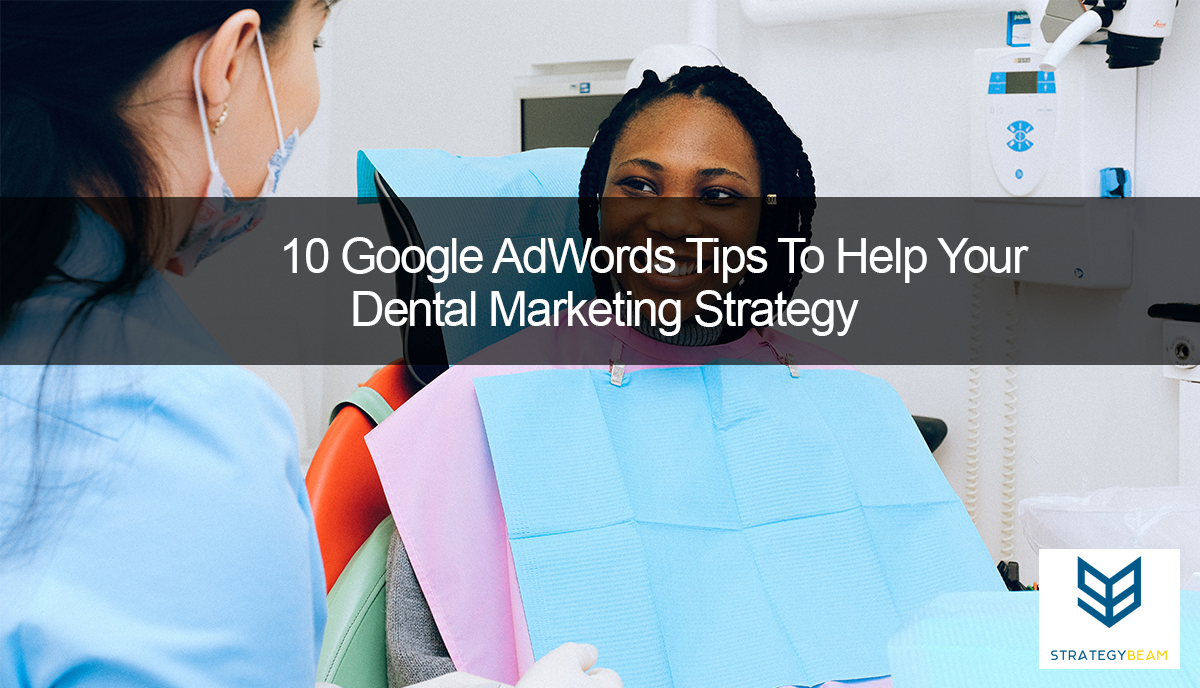
Do you want to grow your dental practice?
Of course, you do… but how can you reach more patients in today’s market?
It can be challenging for dental practices to stand out and attract new patients. Dentists and office managers often grapple with limited marketing budgets, a lack of expertise in digital advertising, and difficulty targeting the right audience. To overcome these hurdles, a powerful marketing tool like Google Ads can make all the difference.
If you want to grow your practice, you need to find a way to boost your presence with digital marketing for dentists that consists of tactics that will get you noticed and drive conversions for your dental clinic.
By targeting specific keywords and demographics, Google Ads lets you focus your marketing efforts on the right audience, leading to higher conversions and a better return on investment. Furthermore, the pay-per-click model ensures you only pay for genuine interest in your services, maximizing the impact of your advertising budget.
Let’s look at how you can advertise to the most clients to get the highest return from your dental marketing strategy with Google Ads today!
Are Google Ads for dentists a good marketing strategy?
Google Ads can be integral to a dental office’s marketing strategy, providing numerous benefits for small dental practices looking to boost leads and drive sales. When used effectively, this powerful advertising platform can help you connect with potential patients actively searching for dental services in your area.
One of the best things about using Google Ads for small business like a dentist’s office is its ability to target specific keywords and geographic locations. This level of granularity ensures your advertising budget is allocated towards reaching a relevant audience, resulting in a higher likelihood of generating leads and converting them into patients.
Another significant benefit of Google Ads is its cost-effectiveness. With a pay-per-click (PPC) model, you only pay when someone clicks on your ad, making it easier to manage your advertising budget and track your return on investment (ROI).
PPC ads are ideal for family dentists because their efficiency is especially valuable for small dental offices with limited marketing budgets that need to secure the lowest cost per click (CPC) possible due to budget constraints.
Moreover, Google Ads provides valuable data and insights, allowing you to measure the performance of your campaigns and make data-driven decisions to optimize results. Continuous monitoring and adjustments can improve your ad effectiveness over time.
In conclusion, incorporating Google Ads into your dental office’s marketing strategy can be a game-changer, connecting you with potential patients and driving growth for your practice.
How do Google Ads work for dentists?
As discussed in the previous section, Google Ads can be an excellent way for your dental office to drive more qualified leads and target specific services you provide to the community.
When a prospective patient searches for a dentist or related services on Google, your ad can appear at the top of the search results, increasing visibility and driving more traffic to your website or office.
With Google Ads, you can target specific keywords relevant to your practice and locality, allowing you to focus your advertising efforts on those most likely to become patients. You can get great returns on your Google Ads campaigns if you use proven tips for Google Ads to get lots of qualified clicks and traffic to your website that lead to more appointments.
However, as your office provides medical care, you must understand the limitations, policies, and regulations to ensure a successful advertising experience. Google places strict guidelines on medical professions through their Healthcare and Medicines guidelines, and here are some points to keep in mind as you build Google Ads for your dentist’s office:
- Restricted content: Google Ads restricts the promotion of specific dental procedures, such as teeth whitening. Review Google’s Healthcare and Medicine policies to ensure your ads comply with these guidelines.
- Patient privacy: When using Google Ads, always prioritize the privacy of your patients. Ensure that any data collected is stored securely, and avoid mentioning specific patient details or case histories in your ads.
- Accurate representation: Your ads must accurately represent your dental practice and the services you offer. Avoid making unrealistic promises or exaggerating claims to attract more leads.
Google Ads is a great way to build brand awareness about your dental office and target the specific needs of potential patients with excellent ad copy. The only thing to remember is that Google has limitations on what you can show and how you can target users since you run a medical facility.
Once you understand the limitations, Google Ads can be a big part of the success of your dental office.
10 tips for using Google Ads for your dentist office
The world of digital advertising can be daunting, especially for dental practices looking to boost their online presence and attract new patients.
Google Ads offers a powerful platform to achieve this, but to truly harness its potential, it’s crucial to understand the best practices and strategies to optimize your campaigns.
In the following section, we’ll outline ten essential tips to help your dental office navigate the Google Ads landscape, ensuring you reach your target audience, maximize your return on investment, and grow your practice.
1. Understand the needs of your potential patients
You have to pay Google each time someone clicks on your ads, so you want to do everything you can to show your ads to the right people at the right time as they are ready to book an appointment with a dentist’s office.
Because of this, it’s essential to think through who your target audience is and the needs that your patients need. Think through who books the appointments with you, what services people tend to book appointments for, and other details about your core audience.
You can take a look at Google Ads auction insights to learn more about your audience if you already have a campaign running.
Here are a few things you can consider as you think about who your potential patients are and what they need:
- Common dental concerns: Identify the most prevalent dental issues faced by your target audience, such as cavities, gum disease, or orthodontic treatments. This will help you craft ad copy that addresses these concerns and showcases your expertise in solving them.
- Demographics: Consider the age, gender, and socioeconomic background of your potential patients. Understanding these factors can help you tailor your ads and services to meet their needs and preferences better.
- Local market trends: Stay informed about dental industry trends in your area, such as popular treatments, pricing, and competitor offerings. This knowledge can help you position your practice as a go-to destination for your target audience.
- Patient feedback: Listen to existing patients and learn from their experiences. Collect reviews, testimonials, and survey data to identify common themes and patterns in patient needs and expectations, allowing you to adapt your approach accordingly.
- Accessibility and convenience: Understand the factors that matter most to potential patients when choosing a dental practice, such as location, office hours, and appointment availability. Ensuring your ads highlight these key aspects can make your practice more appealing to your target audience.
Many dentist offices overlook this crucial step and jump right into keyword research and writing ads, but then they are surprised when their ad campaign fails, and they end up wasting lots of time and money in the process.
I recommend that you write down some bullet points or keep a document where you and your team can place observations to help you identify details about who your potential patients are and their needs.
2. Conduct keyword research
Keywords are one of the most important aspects of a Google Ads campaign. These keywords are the terms you think people use when they search for dental services, and you can bid on specific keywords based on the needs of your potential patients and the services you provide at your office.
Google uses keywords to determine the needs of your patients, and your ads will show if you bid on those same keywords. This means it is essential for you to conduct keyword research to understand what patients search for when they look for specific services so your ads can appear to relevant patients looking for your dental services.
Here are some tips we like to use when researching keywords for dentist offices, and you can use these tips if you choose to set up your own Google Ads campaign:
- Relevance: Focus on keywords directly related to your dental services and practice. This ensures your ads reach potential patients who are actively searching for the specific treatments and procedures you offer.
- Local targeting: Incorporate location-specific keywords, such as your city or neighborhood, to target potential patients in your area. This can help improve your ad’s relevance and increase the likelihood of attracting local patients to your practice.
- Competitiveness: Analyze the competition for your chosen keywords, aiming for a balance between high search volume and reasonable competition. This can help maximize your ad visibility while keeping your cost-per-click manageable.
- Long-tail keywords: Consider including longer, more specific keyword phrases that may have lower search volumes but are more likely to convert. These can often be less competitive and result in better ad performance.
- Ongoing analysis: Regularly review and update your keyword list based on performance data and industry trends. This ensures your campaigns remain current and continue to target the most relevant and effective keywords for your dental practice.
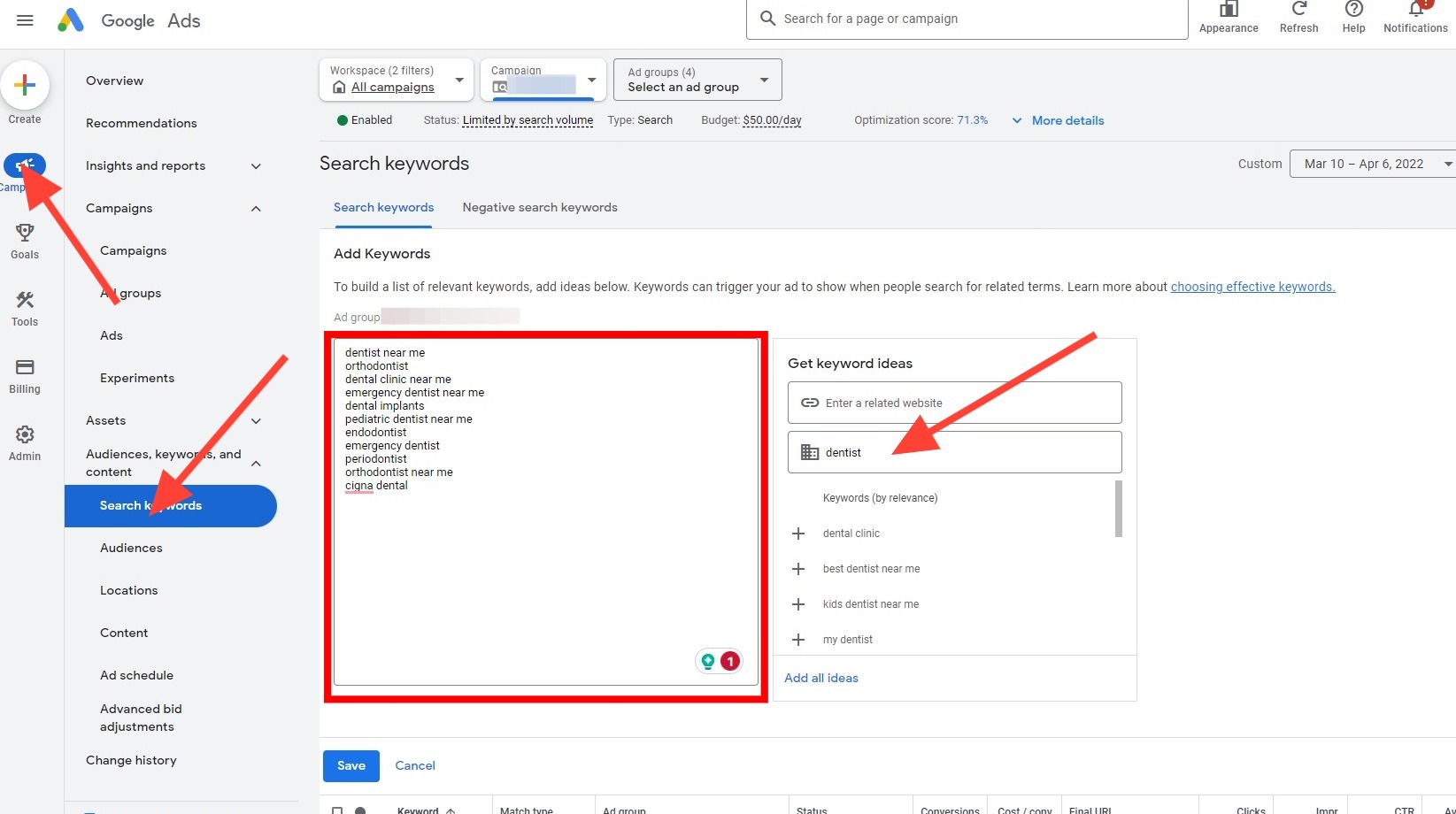
Researching, identifying, and bidding on specific keywords can make or break your dental Google Ads campaign, so ensure you get this process right.
You must understand market trends and evaluate each keyword based on search volume, competition, and potential opportunities to attract and convert qualified leads.
3. Focus on emergency-related keywords
Google Ads are great for grabbing people’s attention when they are ready to buy or book an appointment. This means that Google Ads are an excellent option for your dentist’s office if you offer emergency dental services because patients who need emergency services are more likely to convert into an immediate appointment.
Depending on the services you provide and your customers’ needs (discussed in a previous point), you can build targeted campaigns and ad groups to speak to your office’s ability to address emergency dental services like severe toothaches, broken teeth, and lost fillings.
By incorporating keywords related to these services, you can ensure your ads appear when potential patients are actively searching for immediate assistance. Here are some key factors to consider as you think about keywords for emergency services:
- Specificity: Select keywords that accurately reflect the emergency dental services you offer, such as “emergency root canal” or “urgent tooth extraction.” This ensures your ads reach users who require immediate assistance with these issues.
- Timeliness: Include time-sensitive keywords in your ads, like “24-hour dentist” or “same-day dental appointment,” to highlight your availability and prompt response to emergency situations.
- Location targeting: Combine emergency dental keywords with location-based terms, such as your city or neighborhood, to reach potential patients who require urgent care in your area.
- Negative keywords: Utilize negative keywords to exclude irrelevant searches, ensuring your ads only appear for users who are genuinely seeking emergency dental services.
- Mobile optimization: Since users in need of emergency dental services often search on their mobile devices, ensure your ads and landing pages are mobile-friendly to provide a seamless user experience.
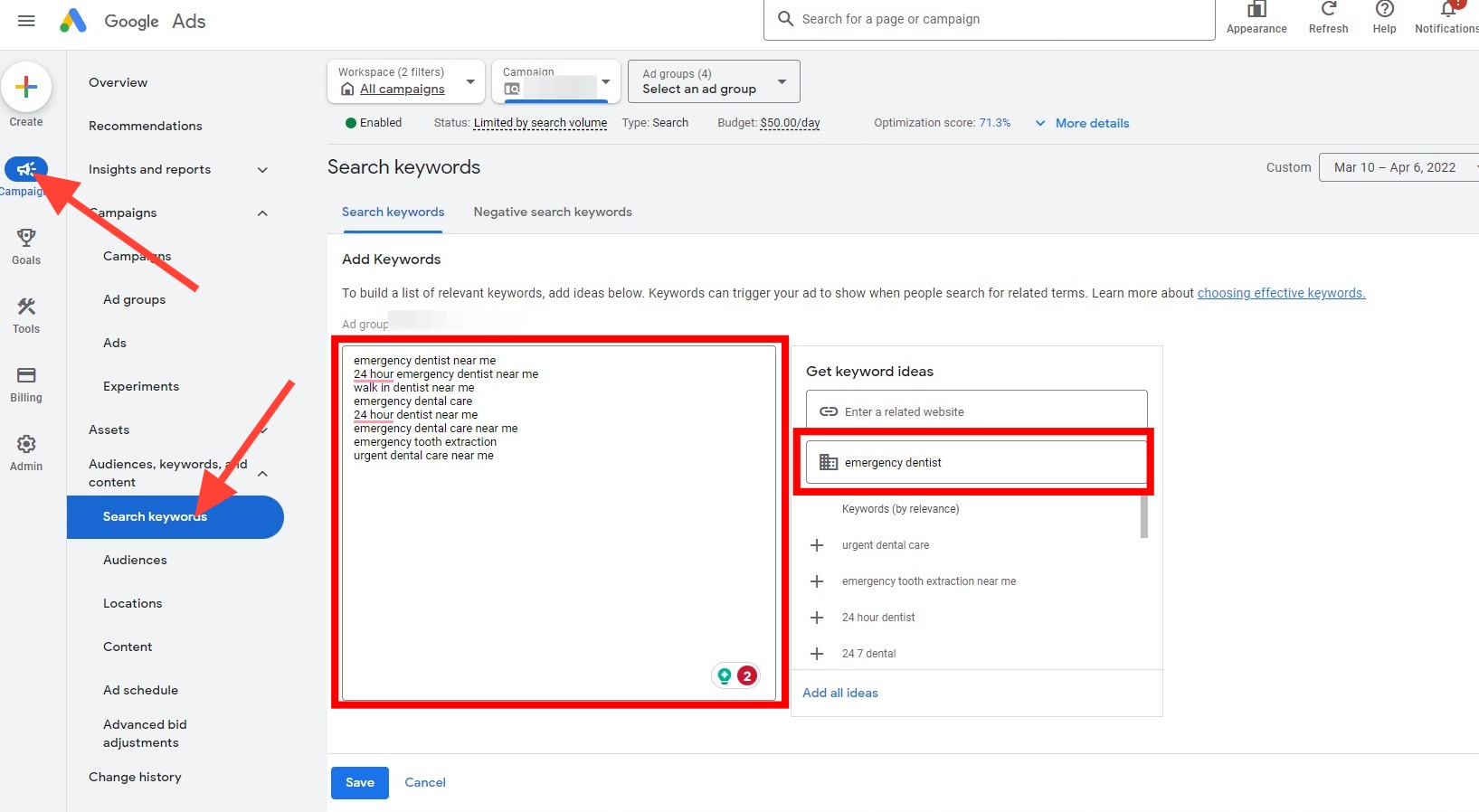
You can start with the needs of your patients and then work backward to the solutions your dental clinic offers to ensure that your dental ads gain traction and drive more patients to your clinic.
By prioritizing emergency keywords and services in your Google Ads campaigns, you can attract a valuable segment of potential patients and grow your dental practice.
4. Adjust ad schedules
Google Ads is a powerful marketing channel to get a specific message to the right audience at the right time. One tool that you can use in a Google Ads campaign is to adjust your ad schedule, which gives you the ability to control when your ads are displayed.
In other words, you can tell Google to only show your ads during a specific period. You can see what times of the day and week people click on your ads by running PPC reporting throughout the month, and you can use this information to adjust your bidding schedule to maximize conversions.
Ad scheduling is essential for dental practices, as potential patients may search for dental services at specific times or days. It’s important to keep ad scheduling in mind because you typically only want to show your ads when your office is open, or you have a call center scheduled to receive phone calls from potential patients.
You can make a significant impact on your conversions and appointments by adjusting your ad schedule, and here are some things to consider as you implement this advanced option in Google Ads:
- Focus on peak hours: Schedule your ads to run during high-traffic periods, ensuring your practice remains visible and top-of-mind when potential patients are most likely to search for dental care.
- Consider your office hours: Align your ad schedule with your practice’s working hours, highlighting your availability and making it easy for potential patients to book appointments when they see your ads.
- Budget allocation: Allocate your advertising budget wisely by focusing your ad spend on the most effective time slots, maximizing your return on investment, and driving more appointments for your dental practice.
- Special promotions: Schedule your ads to coincide with any special promotions or limited-time offers your practice runs, maximizing visibility and attracting new patients with appealing deals.
- Dayparting: Utilize dayparting to divide your ad schedule into specific time segments, allowing you to optimize your ad performance and budget allocation throughout the day. This can help you target potential patients more effectively by focusing on the most valuable time slots.
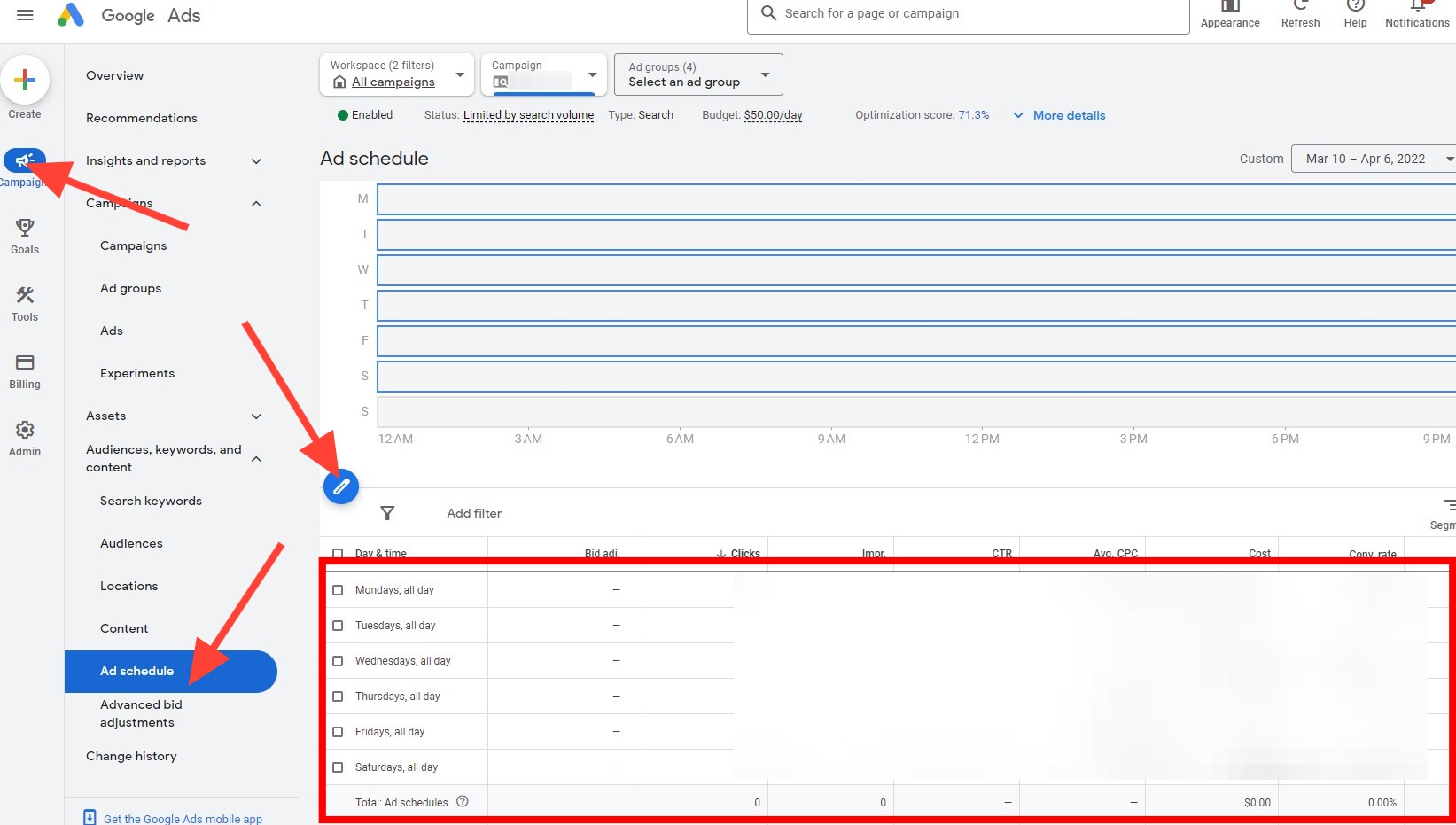
Adjusting when your ads show is a great way to help your ads appear for the right people at the right time. You can use this setting to build better campaigns and ad groups, which we will talk more about in the next section.
5. Setup your campaigns and ad groups with intent
Building a strong foundation is essential when building a house, and the same is true as you build a Google Ads account for your dentist’s office. Your Google Ads account is made of campaigns and ad groups. Each is used to organize your ads and keywords to help your ads show the right people.
Along with keywords, how you structure your Google Ads account is one of the essential parts of running Google Ads for dentists. You can build your campaigns and ad groups to reflect your goals, objectives, and services to help Google and potential patients understand what you offer and what makes your dental services unique.
Organizing your account can be difficult, but you can use AI tools like ChatGPT and Bard to manage Google Ads and make this process easier. You can use these AI tool to give you suggestions on what campaigns and ad groups to build in your account, and this can make a big difference for how efficient your account performs.
For example, you might create separate general, cosmetic, and emergency dental care campaigns. Within each campaign, you can create ad groups targeting specific services or treatments, such as teeth whitening, dental implants, or root canals.
Since the structure of your campaigns and ad groups are so important, here are a few tips to keep in mind to help you organize your account for maximum return on investment (ROI):
- Define your goals: Before setting up campaigns and ad groups, clearly outline your objectives, such as increasing new patient bookings, promoting specific services, or growing awareness of your dental practice.
- Segment by service type: Organize your campaigns based on service categories, like general dentistry, cosmetic dentistry, or emergency care, to create more targeted and relevant ads for each audience segment.
- Specific ad groups: Within each campaign, create ad groups targeting individual services or treatments, allowing you to refine further your ad copy, keywords, and targeting options to match user intent.
- Keyword alignment: Ensure your chosen keywords align with the intent of each ad group, increasing ad relevance and improving overall campaign performance.
- Demographic segmentation: Consider creating campaigns and ad groups that cater to different demographic groups, such as families, seniors, or young professionals, to address their unique dental needs and preferences better.
If you want to get the most out of your Google Ads marketing budget, you need to start by setting up your campaigns and ad groups based on the needs of potential patients and the services your office provides.
6. Focus on local patients
Since your dental practice requires patients to visit your office for services, you must do everything you can to reach and engage with patients in your local area.
Google Ads is a great marketing channel to speak to a local audience to help you generate higher-quality leads and drive more appointments. You can target the local geographic area around your office to increase the likelihood of attracting new patients.
Setting location targeting is easy, and here are some tips to think about as you set geographic targeting options in your Google Ads account:
- Location-based keywords: Incorporate geographic keywords, such as your city or neighborhood, into your ad copy and keyword targeting to reach potential patients searching for dental services in your area.
- Location extensions: Utilize location extensions in your ads to display your practice’s address, phone number, and directions, making it easier for local patients to find and contact your office.
- Focus on your service area: Use geotargeting settings in Google Ads to define a specific radius around your dental practice, ensuring your ads only appear to users within your service area.
- Negative geotargeting: Apply negative geotargeting to exclude locations where you don’t provide services, optimizing your ad spend and focusing your efforts on the most relevant audience.
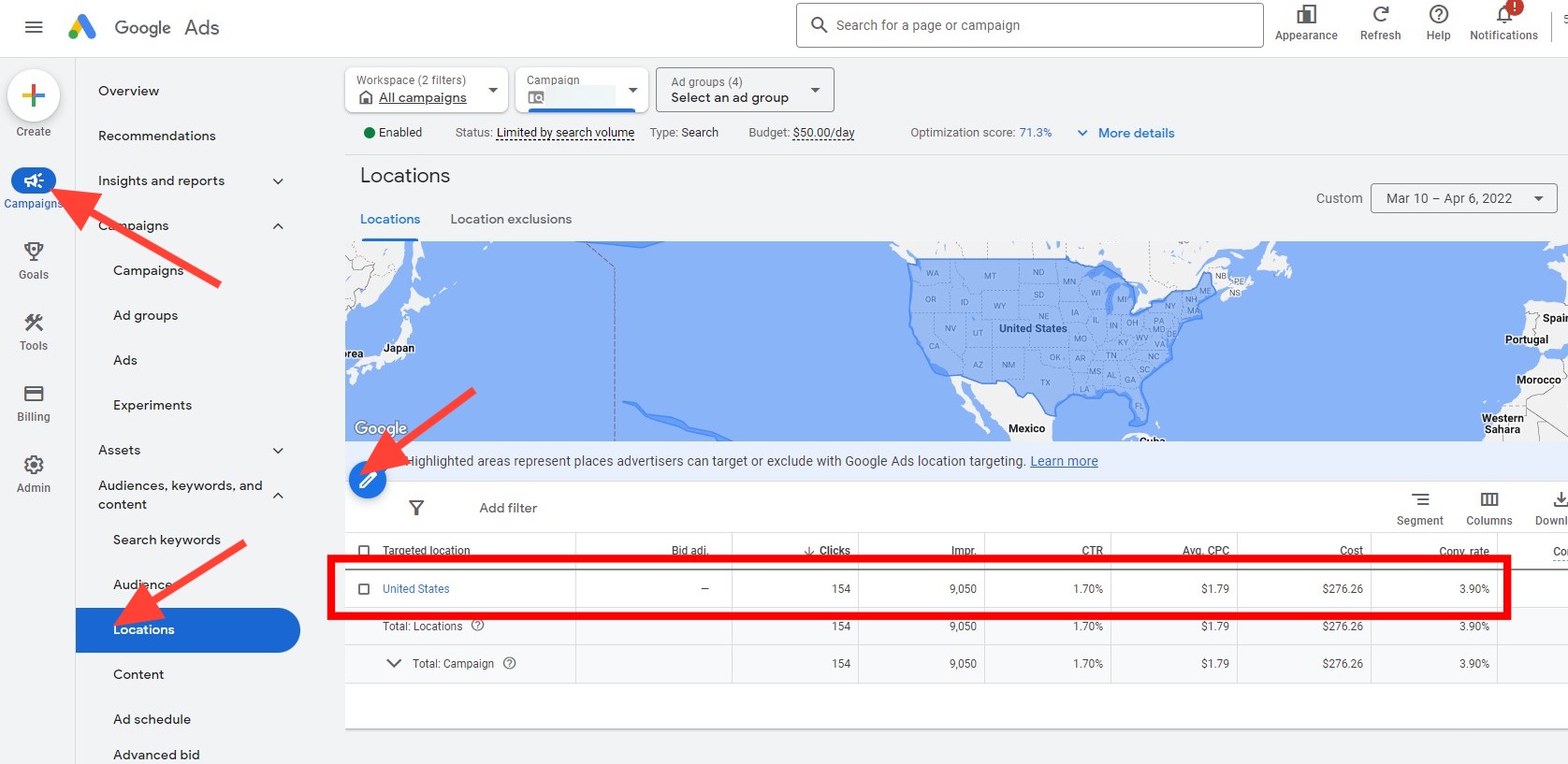
To effectively focus on local patients, employ strategies such as location-based keywords (e.g., “dentist in [city]”), location extensions to display your practice’s address and proximity, and geotargeting to narrow your ads’ reach to users within a specific radius of your dental office.
If your dental office wants to attract more local patients, you should pay attention to geographic targeting options in Google Ads. You can implement this option to ensure your ads only appear to patients in your community, and this can help you optimize ad spend and boost appointment bookings.
7. Create ads that speak to your target audience
The copy you use to write your Google Ads is a central part of your Google Ads strategy because these ads speak to your audience.
Engaging ad copy that effectively communicates the value and benefits of your dental services can grab the attention of potential patients, leading to higher click-through rates and, ultimately, more bookings.
However, great ads won’t write themselves. The good news is that Google responsive search ads make it easy to write excellent ad copy, and here re some tips to keep in mind as you write your next ad:
- Address pain points: Focus on your target audience’s challenges and concerns when seeking dental care, such as dental anxiety or limited appointment availability, and show how your practice can help overcome these issues.
- Highlight unique selling points: Emphasize the aspects that set your dental practice apart from competitors, like state-of-the-art technology, experienced staff, or a wide range of services, to attract potential patients.
- Use strong calls-to-action: Incorporate persuasive calls-to-action that encourage users to book an appointment, request a consultation, or learn more about your services, driving engagement and conversions.
- Test and optimize: Experiment with headlines, descriptions, and calls to action to find the most effective ad copy. Regularly test and optimize your ad copy based on performance data to maximize your campaign’s success.
- Keep it concise: Write clear ad copy that conveys your message quickly and effectively, making it easy for potential patients to understand the benefits of choosing your dental practice.

By highlighting your practice’s unique selling points, such as advanced technology, experienced staff, or flexible appointment scheduling, you can distinguish your dental services from competitors and convince potential patients to choose your practice.
8. Optimize your landing pages
You can have the best ad copy with all the right keywords, but if your landing page is not optimized for your audience, then you won’t be able to run an effective Google Ads campaign.
The job of your landing page is to convert potential patients who click through your ads. A well-designed, user-friendly landing page can effectively convert ad clicks into appointments, ensuring that your marketing efforts yield tangible results.
Since your landing page is so important, we wanted to share a few tips to help you create better landing pages to help you convert more patients and book more appointments:
- Consistency with ad copy: Ensure your landing page content aligns with your ad copy and keywords to create a seamless user experience, building trust and credibility with potential patients.
- Clear calls-to-action: Include prominent, persuasive calls-to-action that encourage visitors to book an appointment, request a consultation, or sign up for special offers, guiding them towards conversion.
- Mobile optimization: Make sure your landing page is mobile-responsive, providing a positive user experience for visitors accessing your website from various devices, including smartphones and tablets.
- Fast load times: Optimize your landing page for quick loading times, as slow pages can frustrate visitors and lead to higher bounce rates, negatively impacting your Google Ads performance.
- Test and improve: Regularly analyze your landing page’s performance, testing different headlines, images, and layout options to identify areas for improvement and optimize your page for maximum conversion rates.
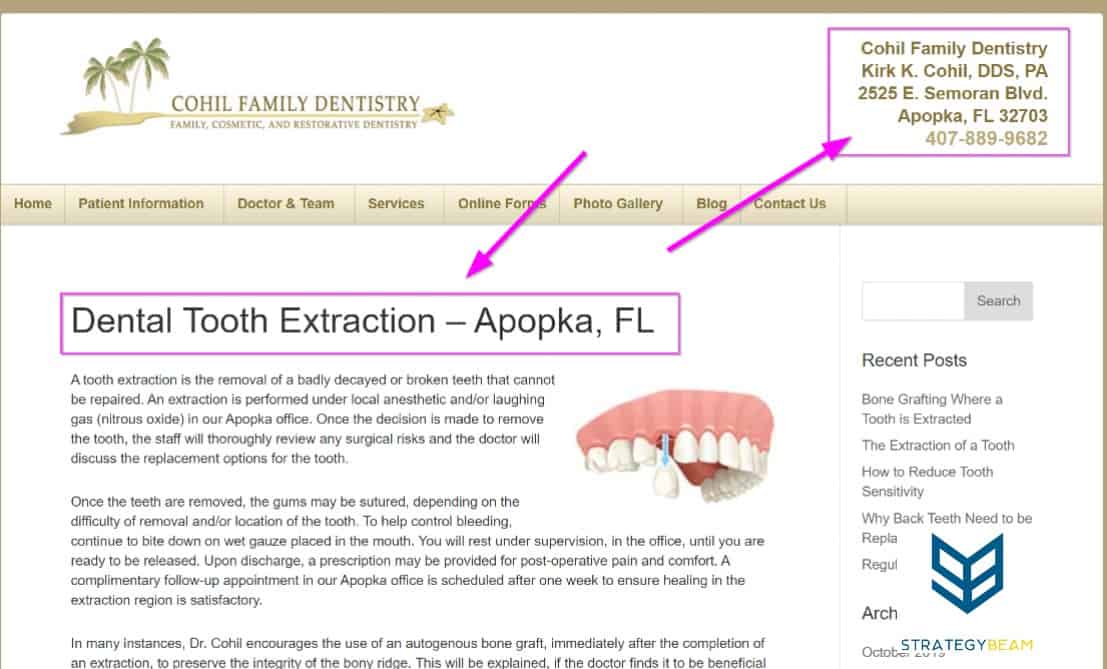
Optimized landing pages can improve your Google Ads Quality Score, leading to higher ad rankings, better ad placements, and lower costs per click. This makes landing page optimization an essential component of maximizing your campaign’s return on investment.
9. Create call-only campaigns
Call-only campaigns are a valuable tool for dentists running Google Ads, allowing them to focus specifically on generating phone calls to their dental practice. With call-only campaigns, your ads appear exclusively on mobile devices, featuring a prominent call button that enables potential patients to contact your office directly with a simple tap.
These campaigns are particularly crucial for dental practices because phone calls are often the preferred method of communication for patients seeking immediate appointments or with specific inquiries. By prioritizing call-only campaigns, you can streamline the patient acquisition process, increase the likelihood of converting leads into appointments, and provide a seamless experience for potential patients.
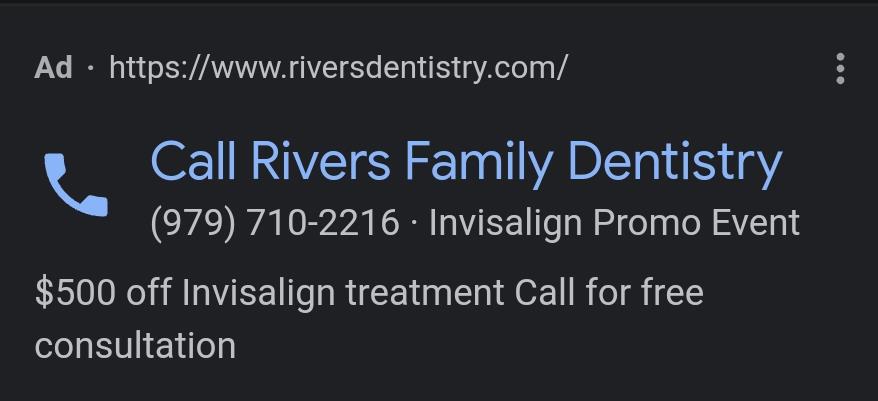
You can optimize your ad spend and minimize wasted clicks by building stand-alone call-only campaigns in your Google Ads account. The nice thing about this type of campaign is that call-only campaigns don’t require your patients to click on a landing page or fill out a form.
Call-only campaigns are a powerful addition to a dentist’s Google Ads strategy, helping to drive phone calls, increase conversions, and ultimately, generate more appointments for your dental practice.
10. Use ad extensions whenever possible
Ad extensions are a valuable feature in Google Ads that allow dentists to enhance their ad campaigns by providing additional information and enticing features to potential patients.
These extensions can include clickable links to specific pages on your website, phone numbers for direct calling, location information, and more. Each extension is meant to perform a specific task, and you can use ad extensions on your ads to help you stand out from the competition and drive more qualified traffic to your website.
Location extension
Location extensions are a valuable feature in Google Ads that allow dentists to showcase their practice’s address, phone number, and map directly within their ads. This extension helps potential patients easily find and contact your dental office, enhancing the convenience and accessibility of your services.
As we discussed in a previous section, your dental office needs to reach local patients looking for the dental services that you offer. You can use a location extension to capture the attention of local patients actively seeking care in your area.
By displaying your practice’s location, you establish trust, credibility, and a sense of proximity, making it more likely for potential patients to choose your dental services over competitors.
Furthermore, location extensions contribute to improving your ad’s performance by increasing visibility, click-through rates, and overall campaign effectiveness. By incorporating location extensions into your Google Ads campaign, you can effectively attract and engage local patients, driving more appointments and achieving greater success for your dental practice.

Call extension
Call extensions are a crucial tool for dentists running Google Ads, enabling them to display their phone numbers directly in their ads. This convenient feature allows potential patients to contact your dental office with just a simple click, making it easier for them to schedule appointments or inquire about your services.
Implementing call extensions is important because phone calls often play a significant role in patient acquisition for dental practices. By prominently featuring your phone number, you increase the likelihood of direct engagement with potential patients, leading to more conversions and appointments.
Moreover, call extensions enhance the overall user experience, streamlining the process for potential patients to connect with your practice. They provide a seamless and immediate way for users to take action, eliminating the need for them to navigate through multiple pages or fill out forms.
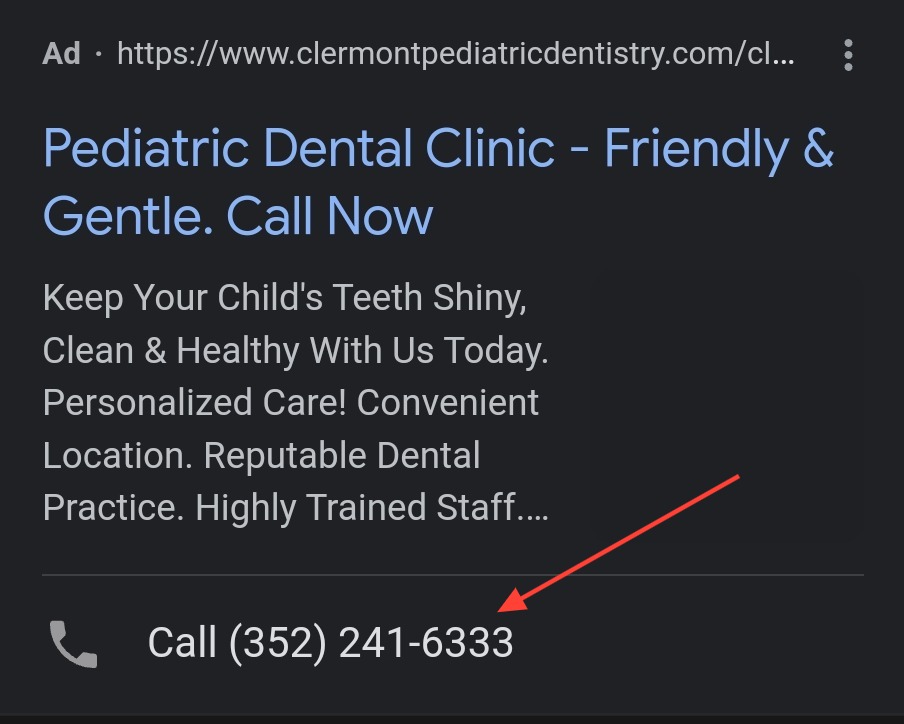
Sitelink extensions
Sitelink extensions are a powerful tool for dentists running Google Ads, allowing them to enhance their ad campaigns by including additional links to specific pages on their websites. These extensions provide users with more options to navigate directly to relevant sections of your website, such as services, patient testimonials, or contact information.
For dentists, sitelink extensions are crucial as they enable potential patients to quickly access the information they need, leading to higher engagement and conversion rates. By strategically utilizing sitelink extensions, you can showcase the breadth of your services, highlight key features, and make it easier for users to find the information that matters most to them.

Promotion extensions
Promotion extensions are a valuable feature in Google Ads that allows dentists to highlight special offers, discounts, or promotions directly within their ad campaigns. These extensions provide an extra layer of visibility and entice potential patients with attractive incentives to choose your dental practice over competitors.
By utilizing promotion extensions, dentists can effectively communicate limited-time offers or exclusive deals, encouraging users to take action and book appointments.
This feature not only increases the chances of capturing the attention of potential patients but also differentiates your practice from others in the highly competitive dental market.

Price extension
Price extensions in Google Ads are a powerful tool for dentists to showcase the pricing information of their dental services directly within their ads. This extension format allows you to display a list of services and their respective prices, providing potential patients with transparency and facilitating informed decision-making.
Implementing price extensions in your Google Ads campaign can be crucial for attracting cost-conscious patients actively searching for affordable dental services. By displaying pricing upfront, you can filter out users who may not be within their budget, saving both parties time and effort.
Grow your practice with ads for dentists today!
Google Ads offers an incredible opportunity for dentists to reach a wider audience, attract new patients, and grow their dental practices.
By leveraging the power of this advertising platform, dentists can effectively target their ideal patients, showcase their services, and generate a consistent flow of leads.
Ready to take your dental practice to the next level with a robust Google Ads campaign? Contact StrategyBeam today, and let us help you build a strong foundation for success. Our team of experts specializes in running effective Google Ads campaigns for dentists, and we’re here to optimize your ROI and drive more qualified leads to your practice.
Take advantage of the opportunity to reach a wider audience and grow your dental practice. Contact StrategyBeam now and let us be your partner in creating a winning Google Ads campaign that boosts your marketing strategy and delivers exceptional results. Get in touch with us today, and let’s embark on this exciting journey together!


Thank you for sharing this blog. This is a great article about Google AdWords for Dental Marketing. Google Ads is a great idea for dental marketing strategies.